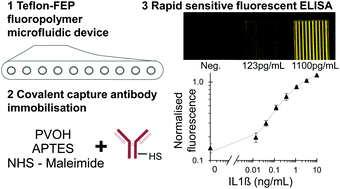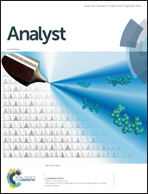Covalent immobilisation of antibodies in Teflon-FEP microfluidic devices for the sensitive quantification of clinically relevant protein biomarkers†
Abstract
This study reports for the first time the sensitive colorimetric and fluorescence detection of clinically relevant protein biomarkers by sandwich immunoassays using the covalent immobilisation of antibodies onto the fluoropolymer surface inside Teflon®-FEP microfluidic devices. Teflon®-FEP has outstanding optical transparency ideal for high-sensitivity colorimetric and fluorescence bioassays, however this thermoplastic is regarded as chemically inert and very hydrophobic. Covalent immobilisation can offer benefits over passive adsorption to plastic surfaces by allowing better control over antibody density, orientation and analyte binding capacity, and so we tested a range of different and novel covalent immobilisation strategies. We first functionalised the inner surface of a 10-bore, 200 μm internal diameter FEP microcapillary film with high-molecular weight polyvinyl alcohol (PVOH) without changing the outstanding optical transparency of the device delivered by the matched refractive index of FEP and water. Glutaraldehyde immobilisation was compared with the use of photoactivated linkers and NHS-ester crosslinkers for covalently immobilising capture antibodies onto PVOH. Three clinically relevant sandwich ELISAs were tested against the cytokine IL-1β, the myocardial infarct marker cardiac troponin I (cTnI), and the chronic heart failure marker brain natriuretic peptide (BNP). Overall, glutaraldehyde immobilisation was effective for BNP assays, but yielded unacceptable background for IL-1β and cTnI assays caused by direct binding of the biotinylated detection antibody to the modified PVOH surface. We found NHS-ester groups reacted with APTES-treated PVOH coated fluoropolymers. This facilitated a novel method for capture antibody immobilisation onto fluoropolymer devices using a bifunctional NHS-maleimide crosslinker. The density of covalently immobilised capture antibodies achieved using PVOH/APTES/NHS/maleimide approached levels seen with passive adsorption, and sensitive and quantitative assay performance was achieved using this method. Overall, the PVOH coating provided an excellent surface for controlled covalent antibody immobilisation onto Teflon®-FEP for performing high-sensitivity immunoassays.

- This article is part of the themed collection: Analyst Recent Open Access Articles


 Please wait while we load your content...
Please wait while we load your content...